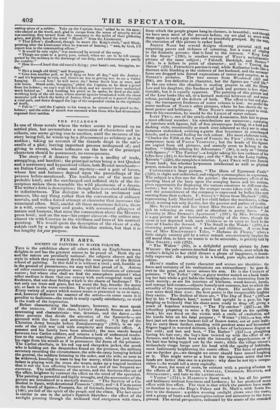giving to events, whose influence on the fate of the
principal characters should be paramount, no consequences. ladye-love (24), is his best design ; and the " Bay in the Long Gallery, The story—if it deserve the name—is a medley of trade, Knowle " (220), the complete st interior. LAKE PRICE will run JOSEPH smuggling, and banditti; the principal actors being a wet Quaker Nam hard ; but whether heapossess intellectual as well as physical and a mercenary and hypocritical villain, both Bristol merchants— power, remains to be proved. an Italian Count, all crime and mystery—and a pair of lovers, CATTERMOLE'S large picture, " The Horn of Egremont Castle" whose fate and fortunes depend upon the proceedings of the (120), is slight and unfinished, and vulgarly commonplace in expression. persons before-mentioned. The incidents are of the most im- The subject is a fine one for the painter : the momentary effect of the probable kind; and the surcharged and inflated style of the de- sturtling blast of the horn upon the usurping baron and his retinue, scription makes them resemble the wild phantasms of a dream. gives opportunity for displaying the various emotions in different cha. The writer's forte is description; though this is overlaid and diffuse meters ; but in this instance the usurper seems taken with the colic, to indistinctness. The dialogue is affected in sentiment and and the astonishment of the company is expressed by bullet-like eyes starting from their sockets. F. STONE'S " Scene from Macbeth" (192), manner, like any thing rather than the conversation of ordinary representing Lady Mucduff and her child before the murderers, is thee- mortals, and with a forced attempt at character that increases the trice], wanting not only dignity, but the passion and pathos of reality. unnatural effect. Still, amidst all these monstrou4 defects, there Mrs. SIAITARTII and her sister Miss SHARPE arc as brilliant and is a wild, coarse vigour and gusto, with occasional glimpses of rich in colouring as ever, and as abundant in pretty faces. " An nature and humour, that raise the composition above the Minerva Pveni ig i t Miss q tewares Apartment " (191), by Mrs. Si:imam, press level ; and on the sea—his proper eleinent—the author may is a gay picture of the fashionable frivolity of the time, though the almost vie with COOPElt in the vividness and force of his nautical scene is not depicted with such vividness as to carry us back to the painting. We would quote the description of the chase of a shy time of Charles the Second. " 'rlie Stroll in the Woods " (219), is a rakish craft by a frigate on the Gibraltar station, but that it is charming portrait picture of a mother and children. A scene from


























 Previous page
Previous page